Here on our homestead tucked in the mountains of Western Pennsylvania, we have a wonderful greenhouse made from recycled materials. The base is a carport my friend had her farm and offered the greenhouse to me when she moved. This greenhouse thus has 15+ years of good, growing energy in it. The greenhouse is one of my favorite places—I love the smell, the things growing, and especially the giant, abundant Chicago hardy fig in the middle of the space. We grow food year-round in the greenhouse. In the harshest of winter weather when the windchill is below zero, we even put our birds in there to shelter from the storms. In the winter, when the sun is low in the sky, I go in to bask in the winter sunlight and fight against seasonal affective disorder.
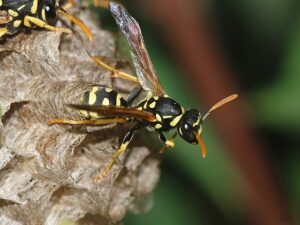
This year, two communities of paper wasps (Polistes dominula) moved into the greenhouse in the spring. In early June, I was weeding the greenhouse, having recently planted summer crops like peppers, beans, and tomatoes. As I worked the greenhouse, I was stung three times on the hand and then looked up into the framing of the greenhouse to realize a big paper wasp nest was there. I went around to go into the greenhouse from another side and found a second nest, tucked in under my recycled wood potting table.
Now, let me be clear—these nests were in a very bad place. They were right in the middle of the garden, meaning that I would have to be wary and warn any guests. They also were at both doors of the greenhouse, meaning the greenhouse was basically inaccessible all summer (losing our summer harvest and fall/winter crop planting opportunities). Most unfortunately, one nest was near each greenhouse door, so there was no safe way into the greenhouse. The nests, at both ends, meant being in the center of the greenhouse risky.
Thinking about it from it only from a human convenience perspective would probably lead most people to their nearest box store to purchase weed killer. But as a druid, I chose to approach the problem with gratitude and care. First, I recognized that the wasps were equal to me as members of the ecosystem and land, they had the right to live here just as I did. I was grateful to them because they were in our garden doing good work. They help pollinate and they prey upon caterpillars, which is particularly helpful since we have an ongoing problem with cabbage moths. Every day, I cast a Sphere of Protection around the homestead and include all life in my protection. They represent a long line of many generations of wasps, certainly living here before we got here about 8 years ago. How could I harm them? How would I feel if I didn’t treat these people in love and care, respecting their sovereignty? How was “the problem” actually “the solution”?
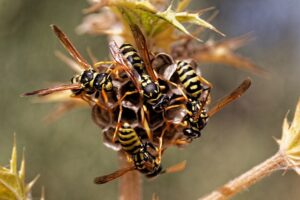
So, I began to sit with the wasp nest. I watched them from a safe distance, outside the greenhouse but where they could see me. They had those that went out foraging, they had the guards, always watching me, crouched on the edges of their nest. They had those who were rearing the young. The community was maybe 20-30 wasps in the height of summer and their growing nest was about 4-5” across. I spoke to them, went near them every day, sang and played music for them, and reached out with my heart and spirit to share my gratitude they were there. I worked to have them understand I was not there to harm them. I made sure the greenhouse fan stayed on so that they would not overheat during the many hot and dry days of the drought. I left small bowls of water in the doors of the greenhouse so they could get a drink.
Meanwhile, some very beautiful and delicious tomatoes were ripening right where the big nest was. The heat and the drought were so bad all summer, and thus, we lost a lot of tomatoes in the main garden. Some of the nicest tomatoes in the greenhouse were less than a foot from their nest. I asked, “Can I pick?” I got no response, which meant they were neutral to have me proceed. I entered the greenhouse. The warriors watched me, antennas out and tracking my movements. I moved closer to the tomato plant and picked the first tomato carefully from about 4 feet away from the nest. I did not bump the tomato plant (whose leaves were very close to the nest), and I didn’t take any tomatoes too close to the nest. I picked a handful, and then I got the clear message that they had had enough. I came back the next day, and the next, always picking only a few, slowly getting closer to the nest, never stirring things up. After a few visits, we worked out a truce—they would allow me to come in and out of the greenhouse, slowly, away from the nest and then I was allowed to pick, as long as I stayed about 18″ from the nest. If I disturbed the tomato plant too close to their nest or picked too close to their nest, all bets were off. Thus, we established a truce that worked where we all got what we needed (with some concessions and sacrifice) and we learned to live together. The figs came in – thankfully another bumper crop. The second hive, which was closer to the fig, again negotiated with me to harvest.
Over the course of the season, we eventually moved from tolerance to a place of mutuality and gratitude for each other.
August came. We planted rotations of lettuce, kale, broccoli, rapini, radish, fall carrot, and turnips in the gardens outside. The kale I had seeded heavily, with the goal of transplanting a number of them into the greenhouse if given the chance. I was certain the wasps would not tolerate me disturbing the plants to remove them or seed directly.
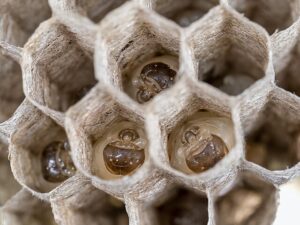
Meanwhile, the wasps had their own wheel of life turning. While the nest was very active and large between Midsummer and the Lughnasadh, as we approached the Fall Equinox, their numbers dwindled, and the fierce energy they were putting off started to wane. By mid-September, only a few were left. I didn’t see the last of them leave. I learned that the “foundresses” and their mates fly off to hibernate somewhere while the workers die at the end of the season. One day they were there, and one day they were all gone, leaving a beautiful, roughly circular nest of gray paper. The sacred geometry in the design was incredible. Wasps make hexagons (six-sided structures) just like honeybees, but for them, they make them of paper. The hexagon is the strongest shape in nature, and it offers symmetry, strength, and efficiency. While most of the cells that store their honey, pollen, or eggs are six-sided, the wasps also use some 5- and 7- 7-sided cells that will help them correct an issue with the construction of their hive. It was a magnificent structure.
I cleared the greenhouse of the summer plants, leaving the nests where they were. The fall crops went in, and the fig continued to be extremely bountiful—our most successful harvest of almost 9 lbs of figs from one tree (and as I write, the fig is losing leaves but still ripening and has at least 2-3 lbs more of fruit left to harvest!) The greenhouse was the most abundant part of our gardens this year. The outdoor gardens suffered a lot due to the ongoing heat and crippling drought. I think that part of the greenhouse abundance was the energy of the wasps. These wasps pollinate our land. They eat the most destructive insect pest in our ecosystem, and they bring abundance.
In reflection, this entire experience taught me a lot about care, gratitude, and respecting sovereignty. These are some of the most important values, values that take a long time to bring into practice, particularly when you are shedding off cultural values that teach the opposite. Experiencing this interaction with the wasps was the result of many years of trying to learn how to live a care-filled life. I feel like these are areas that I will work on for the rest of my life. I could have gone to war with the wasps. I could have easily bought some awful chemicals and sprayed them with poison, identifying them as an inconvenience that was quickly disposed of. But I chose a different path, a harder path, but in the end a much more rewarding one.
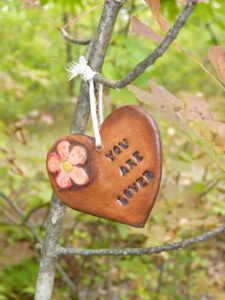
Care, gratitude, and respecting the sovereignty of all living beings are values that I believe we need to embrace to build a better future. I know how hard the last week and a half has been for so many people in the United States. The impact of this decision will be felt globally, and I think many see it as a path to a bleaker future. Last week, I had a post I had written a few weeks ago ready to share. But, I couldn’t post anything. I had to go silent while I collected my thoughts and processed the myriad of emotions. I think there are a lot of forces right now trying to bring out the worst in us. I had to come to terms with the fact that this decision is going to hurt a lot of people (humans and natural beings) that I care about. And it will most certainly will derail efforts to curb climate change and the 6th mass extinction. Because of that, I spent a lot of time in grief, anger, and utter despair that I am still working through.
But writing the story of the paper wasps helped set my thinking and my heart on a better path. Care, gratitude, and respecting the sovereignty of all beings is a critically important triad to embrace in this challenging age. The question that we get to ask ourselves each day is “How will I approach the world today?” What energy do you want to bring in? Will you approach the world in love, care, and gratitude? Will you approach it in justified anger? Will you approach it in darkness and sorrow? Perhaps you’ll approach it in all of these things. I think each of us has to find our own path through the coming months and years, and I honor whatever path you choose for the reasons you choose it. For me, I’ll keep offering my care, gratitude, and respect to all living beings because that feels in line with the future I want to create.
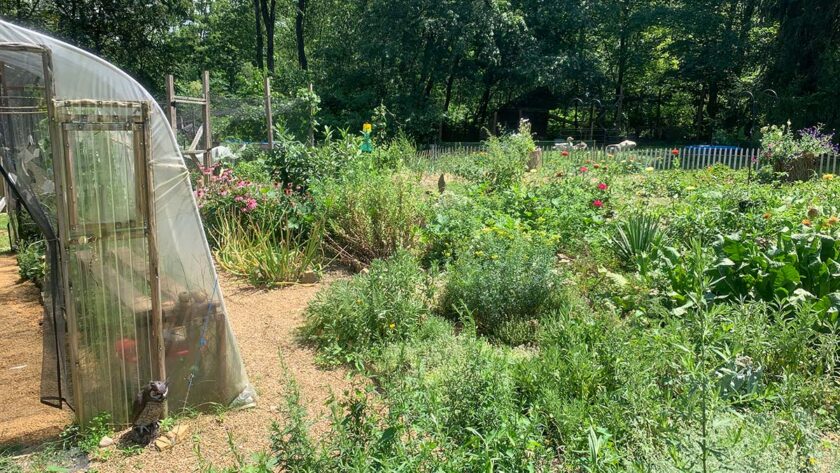



yes
Indeed 🙂
Thanks for the lovely story about the paper wasps. Don’t be too disheartened about the decision your fellow Americans have made. It will certainly affect us who live in most of the world because the American dollar is the major currency used in trade, but as far as climate change goes, I don’t think anything anyone does, or does not do, will impact that. Astrologically speaking, the earth, sun and moon along with earths magnetosphere are responsible for that. Carbon in the atmosphere in past epics has been 500 times what it is now and the earth was in an ice age then. The level of carbon is not causing heating. It’s the earthly cycle over which we have no control. That said, humanity could definitely stand to learn a lot about caring for nature and her creatures, including us. Compassion and gratitude are both underrated. Blessed be.
Hi Jodie, Thanks so much for your comment. I don’t agree with you on the causes of climate change, but we definitely agree on learning to care, and on compassion and gratitude! Thanks for reading! 🙂
Beautiful. This is a very uplifting experience you have shared. Thank you.
Thank you Ka Malana! And thank you for reading.
My pleasure 💛
Thank you for your extremely inspiring post.
You are welcome, thank you! 🙂
A synchronicity – I have a similar story about paper wasps.
Around June I discovered that paper wasps had built a nest perhaps two feet from the door into our kitchen (the door we and most visitors use as the main door into and out of our house) and another nest perhaps two feet from the door into our back porch from outside. I saw it before any of the wasps stung anyone. My husband Mike and I agreed not to harm them, but we still needed to be able to get into and out of the house and into and out of the back porch.
So I promised the wasps we would not harm them, and I started offering a blessing to the wasps every time I used either door. During gardening season, when I enter and leave through the back porch to get to the garden in the back yard, that was multiple times a day. Whenever I knew someone would visit us, entering through either door, I told the wasps about it before the visitor arrived and asked the wasps respectfully to allow the visitor to enter and leave, then blessed the wasps.
Because the nest on the back porch was visible from a porch window, I watched the nest and the wasps all summer long and while they were still active in autumn. It was fascinating, an opportunity to learn about their ways that I would have never had otherwise.
By now, the nests are no longer active. I continued to bless the wasps every time I went through the door until I saw no more of them. The wasps never stung anyone. They went about their lives and we went about ours with mutual, if wary, respect.
Hi Claire! I love that you have a similar story. It must have been the year for the wasps. I find that they are most agreeable and you can totally negotiate with them. The wasps only stung me once, and it was when I discovered the nest and was not paying attention–I began weeding in the corner where their nest was, and they defended their space. But after that, nobody has gotten stung. The negotiation and respect worked well. I wonder what next year will bring for the wasps!
I needed this today. Thank you.
Glad I could help, Lisa!
This summer I had an experience with Angelica that taught me a harsh lesson in respect and humility and gratitude for the inhabitants of my garden. I took out a large, flowering stalk of the mother plant to avoid having her blast out seeds and spread all over the place – without any prior conversation or approach in a respectful way. The result is that I got a nasty third degree burn on my hand from the defensive juices, and it lasted about three weeks. The Ojibwe people refer to the plant as Ma’ingwake, associating the plant with wolves. The Mama wolf bit me when I reached into the den and tried to mess with her pups. Now I make offerings and converse with Ma’ingwake before I collect any parts of her for my own use. So far so good.
Thank you for this piece that acknowledges our grief with the results of the election. Despite our call to remain neutral, there will be effects on the living Earth that are not what we need.
Oh…Angelica certainly let you know how she felt about the action. But I think that when we have a harsh lesson like that, and we are willing to learn from it, we can develop a much deeper relationship with the plant. Sage and I had a situation that wasn’t dissimilar, and it took a few years for us to get back on good footing. Now we are very close.
I think a lot of people are really having a hard time with coming to terms for what the future may bring for the US for lots and lots of reasons. I have been saddened to see how many people are fearful and shocked. I am praying that it won’t be as bad as many fear. I am very saddened to think of the many environmental protections that will be lost and that we will be going in a bad direction with regards to the land. So yeah, definitely acknowledging that here.
Massive respect for the discipline to which you adhered in not destroying your cohabitants.
Thank you for sharing this and showing how to coexist with creatures that frighten us.
…
/|\
Thanks J. Donald! The wasps are definitely scary…but I will say that I feel a lot less frightened of them now that I’ve had this summer’s interaction. I think as long as I treat them like any other being that needs to be deeply respected and that I need to stay on my guard around (such as our poisonous plants) it will be ok. I am harmed when I am the one who is not paying attention. Blessings to you :).
Ooh! I love this post and appreciate when others share their beautiful experiences with wasps. Three years ago they made a home in the duck house (it’s an old shed we converted, so the ceilings are quite high and peaked). Every morning when I’d open the door to let the ducks out, there would be a row of patient wasps waiting to get back inside to their nest; then all day long, in and out and they’d go. They never paid any mind to the ducks and Goose or myself and everyone just existed together. No fear or malice. Just space and respect. Once their life cycle ended, this gorgeous free form nest sat vacant until a pair of house wrens moved in! Every evening they’d flit into the cedar next to the duck house, chitter to their mate and then they’d both head inside to tuck in for the evening. Each morning, after the ducks and Goose left, they’d fly out and enjoy their day.
Since then I’ve had wasps under my siding twice, in the garden, in the greenhouse… they quite like it here because we respect and appreciate them.
I view them as protectors of my home space, alongside bittersweet nightshade. I’ve noticed when they build nests in areas that function as entry points to my home (the side gate, the front window, the walkway etc….) they show up in areas that bittersweet nightshade was/is also growing; a plant I work with as a protector.
Wasps and bittersweet nightshade are great companions to have.
Thank you for sharing your story!
Hi Nikki, I love your story about the wasps and how they understood that everyone was sharing that doorway! Also, I love that you have Goose. You must see the photos of my geese on this blog from time to time, they are like my children, lol! I love how the wasps paved way to the wrens. It sounds like you have a wonderful doorway full of many beings who take refuge! Thanks for sharing :).
I have had a ground wasp and paper wasp encounter I treated similar to you. Some say I hold the energy of a queen Bee, because I have always been able to garden around them all without being stund—with one exception. A new group took over an older ground hive and regardless, guards went after me when I approached about 3 feet away. Instead of killing them, I closed that particular hole, which forced them to relocate the second entry point (they have multiple).
I leave nest for the same reason you do.
The Divine created them before us. All creation before humans are our ancestors and they deserve our respect and honor toward them and their part in our world.
I love how you were able to work with the wasps and redirect their energy. Thanks for sharing!
dear Dana, thank you for this post. it really resonated w me for a couple reasons. I too had a paper wasp nest in my greenhouse this spring as i do most years. I usually use vinegar and natural oils to spray the nest early on so they choose to build somewhere else. THis year i made a truce w them that if they dont harm me, i wont harm them. They made more and more nests and were very active. It got so i only went in to water and harvest in morning and eves when they were quieter. I never got stung tho!
I will be knocking down their old nests this winter and will consider how to proceed in the next year.
Also, Ivan’s last act before dying was spraying toxins on a paper wasp nest that was very close to a camp site on the land here. We had been in disagreement about how to deal w this to keep our campers safe. I finally gave in when it was still there and we had an event starting. He did the deed and then had a heart attack.
I respect the wasps and am glad to know more about their role in gardens and land.
with love
fearn